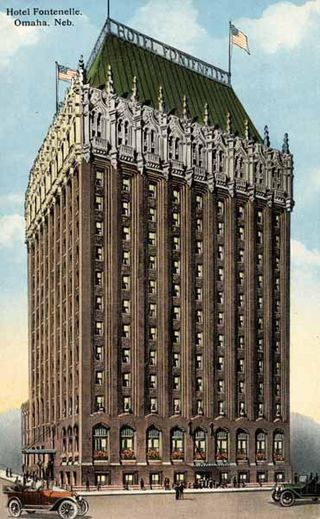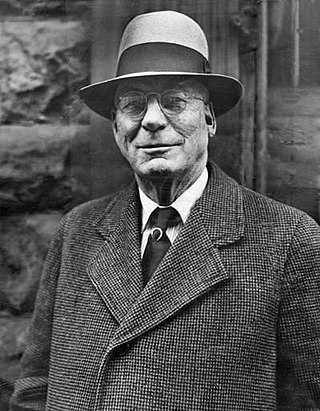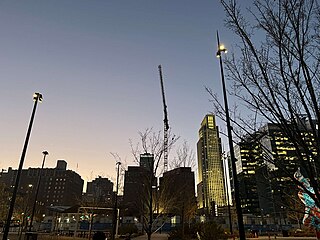
The Everleigh Club was a high-class brothel which operated in Chicago, Illinois, from February 1900 until October 1911. It was owned and operated by Ada and Minna Everleigh.

Omaha is the most populous city in the U.S. state of Nebraska and the county seat of Douglas County. It is located in the Midwestern United States along the Missouri River, about 10 mi (15 km) north of the mouth of the Platte River. The nation's 40th-most populous city, Omaha had a population of 486,051 as of the 2020 census. It is the anchor of the eight-county Omaha–Council Bluffs metropolitan area, which extends into Iowa and is the 58th-largest metro area in the United States, with a population of 967,604. Furthermore, the greater Omaha–Council Bluffs–Fremont combined statistical area had 1,004,771 residents in 2020.

A red-light district or pleasure district is a part of an urban area where a concentration of prostitution and sex-oriented businesses, such as sex shops, strip clubs, and adult theaters, are found. In most cases, red-light districts are particularly associated with female street prostitution, though in some cities, these areas may coincide with spaces of male prostitution and gay venues. Areas in many big cities around the world have acquired an international reputation as red-light districts.

The Omaha Race Riot occurred in Omaha, Nebraska, September 28–29, 1919. The race riot resulted in the lynching of Will Brown, a black civilian; the death of two white rioters; the injuries of many Omaha Police Department officers and civilians, including the attempted hanging of Mayor Edward Parsons Smith; and a public rampage by thousands of white rioters who set fire to the Douglas County Courthouse in downtown Omaha. It followed more than 20 race riots that occurred in major industrial cities and certain rural areas of the United States during the Red Summer of 1919.

The Levee District was the red-light district of Chicago from the 1880s until 1912, when police raids shut it down. The district, like many frontier town red-light districts, got its name from its proximity to wharves in the city. The Levee district encompassed four blocks in Chicago's South Loop area, initially between Harrison and Polk, between Clark and Dearborn, and then the newer Levee district, between 18th and 22nd streets. It was home to many brothels, saloons, dance halls, and the famed Everleigh Club. Prostitution boomed in the Levee District, and it was not until the Chicago Vice Commission submitted a report on the city's vice districts that it was shut down.

The history of Omaha, Nebraska, began before the settlement of the city, with speculators from neighboring Council Bluffs, Iowa staking land across the Missouri River illegally as early as the 1840s. When it was legal to claim land in Indian Country, William D. Brown was operating the Lone Tree Ferry to bring settlers from Council Bluffs to Omaha. A treaty with the Omaha Tribe allowed the creation of the Nebraska Territory, and Omaha City was founded on July 4, 1854. With early settlement came claim jumpers and squatters, and the formation of a vigilante law group called the Omaha Claim Club, which was one of many claim clubs across the Midwest. During this period many of the city's founding fathers received lots in Scriptown, which was made possible by the actions of the Omaha Claim Club. The club's violent actions were challenged successfully in a case ultimately decided by the U.S. Supreme Court, Baker v. Morton, which led to the end of the organization.

Tom Dennison, known as Pickhandle or Old Grey Wolf, was an American political boss and racketeer in Omaha, Nebraska. A politically savvy, culturally astute gambler, Dennison was in charge of the city's wide crime rings, including prostitution, gambling and bootlegging in the 1920s. Dennison is credited with electing "Cowboy" James Dahlman mayor of Omaha eight times, and when losing an election, inciting the Omaha Race Riot of 1919 in retribution against the candidate who won.
Sheelytown was a historic ethnic neighborhood in South Omaha, Nebraska, USA with populations of Irish, Polish and other first generation immigrants. Located north of the Union Stockyards, it was bounded by Edward Creighton Boulevard on the north, Vinton Street on the south, South 24th Street to the east, and 35th Street to the west. Sheelytown was named for the Sheely Brothers Packing Houses that were located in the area. Sheelytown was annexed by Omaha in 1887. The Omaha Quartermaster Depot was built just east of the community across the Union Pacific tracks.
The Burnt District was the original red light district in Omaha, Nebraska in the late 19th century. The area was located east of Creighton University from Douglas Street six blocks north to Cass Street and from the Missouri River west to Sixteenth Street, centered around the area currently containing Pioneer Courage Park.
Crime in Omaha, Nebraska has varied widely, ranging from Omaha's early years as a frontier town with typically widespread gambling and prostitution, to civic expectation of higher standards as the city grew, and contemporary concerns about violent crimes related to gangs and dysfunctions of persistent unemployment, poverty and lack of education among some residents.

Downtown Omaha is the central business, government and social core of the Omaha–Council Bluffs metropolitan area, U.S. state of Nebraska. The boundaries are Omaha's 20th Street on the west to the Missouri River on the east and the centerline of Leavenworth Street on the south to the centerline of Chicago Street on the north, also including the CHI Health Center Omaha. Downtown sits on the Missouri River, with commanding views from the tallest skyscrapers.
Jack Broomfield (1865–1927) was an African-American community activist and political leader in Omaha, Nebraska in the early 20th century.
Joe Coe, also known as George Smith, was an African-American laborer who was lynched on October 10, 1891, in Omaha, Nebraska. Overwhelmed by a mob of one thousand at the Douglas County Courthouse, the twelve city police officers stood by without intervening. Afterward, the mayor called the lynching "the most deplorable thing that has ever happened in the history of the country."
Dan Allen was a pioneer American gambler in Omaha, Nebraska. He had great influence throughout the young city and was the long-time companion of Anna Wilson, the city's foremost madam for almost 40 years. Allen was influential throughout early Omaha.
The Irish in Omaha, Nebraska have constituted a major ethnic group throughout the history of the city, and continue to serve as important religious and political leaders. They compose a large percentage of the local population.
Gambling in Omaha, Nebraska has been significant throughout the city's history. From its founding in the 1850s through the 1930s, the city was known as a "wide-open" town, meaning that gambling of all sorts was accepted either openly or in closed quarters. By the mid-20th century, Omaha reportedly had more illicit gambling per capita than any other city in the nation. From the 1930s through the 1970s, the city's gambling was controlled by an Italian criminal element.

Ada and Minna Everleigh, born Ada and Minna Simms, were two sisters who operated the Everleigh Club, a high-priced brothel in the Levee District of Chicago during the first decade of the twentieth century. Ada, the eldest, was born in Greene County, Virginia on February 15, 1864, and died in Charlottesville, Virginia on January 5, 1960. Minna was born in Greene County on July 13, 1866 and died in New York City on September 16, 1948.

The Sporting District was a red-light district in the U.S. city of San Antonio, Texas in the late 19th and early 20th centuries. It was established by the city council to manage prostitution in the city. For a time it was one of the nation's largest vice districts with venues ranging from brothels to gambling halls. The area was officially shut down in 1941 resulting from the mobilization for World War II.

The history of vice in the U.S. state of Texas has been an important part of the state's past and has greatly influenced its development. Vice activities, such as gambling and prostitution, have historically been a significant facet of both the state's culture and its economy.
Victor B. Walker was an American soldier, political activist, lawyer, civil rights activist, police officer, saloon owner, journalist, and gangster in the Old West, particularly in Omaha, Nebraska, and in Denver, Colorado, at the end of the 19th and beginning of the 20th century. Before coming to Omaha, he was a Buffalo soldier on the frontier, and when he first arrived in the city, he worked as a police officer. For a short time, he owned the Omaha saloon, The Midway, a center of gambling and criminal activity in the city. As well as a working as defense lawyer, he worked for civil rights and was a member of the Omaha Afro-American League, a civil rights organization in the city.











